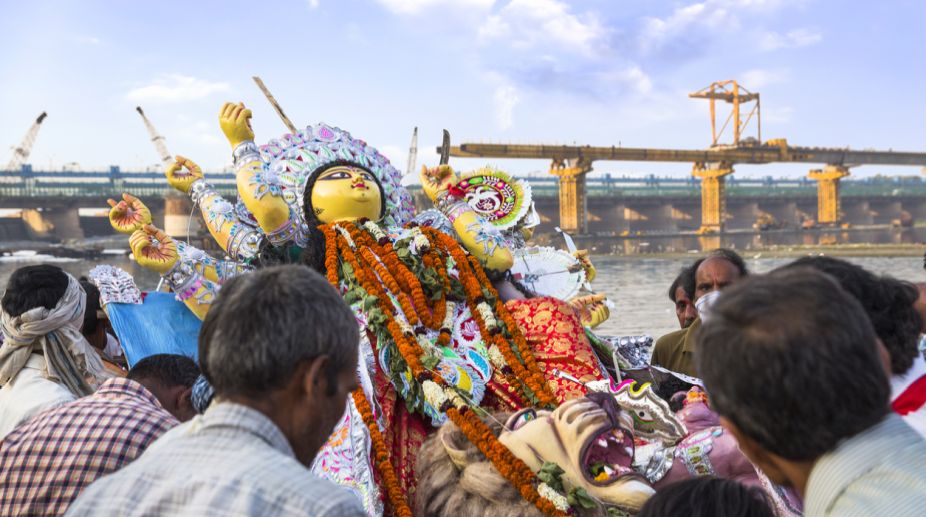Fleeting time
It’s Bijoya Dashami already, the time to wish, hug and gorge on sweets. Fun and frolic reigns supreme. Even elders too can’t seem to resist themselves from indulging in the merry making. Dashami begins with relatives pouring in and out of the houses.
Advertisement
Tables fill up with sweets. One always looks for a chance to nail down his favourite sandesh even the strict diet followers forget their ties. Yet, in a corner of our hearts it pricks that puja passed so quickly. It feels that the enjoyment is still incomplete and a day or two would have sufficed. As the sky turns dusky rose-pink, the rhythmic beats of the dhaks (drums) can be heard from a distance reminding that it’s time to bid adieu to the Goddess.
The horizon lights up with fire crackers as the idols are carried from the pandals for immersion in the holy Ganges. The streets start filling up with people. Soon some curious heads peek here and there to know about the whereabouts of the much awaited truck. As the sound of its engine overpowers the ear-splitting loudspeakers, everyone gets ready with phone and cameras. After a spell of shutters, the Goddess is seen having her own unique regal beauty mixed with unparalleled artistry.
The joyous ‘dhakis’ make everyone’s feet tap to the beats, few people even in their fifties or sixties could be seen dancing. As the procession passes, the tail end is occupied by Disc-jockeys playing some unidentifiable music followed by a huge wave of people in their teens. Altogether it’s an experience quite difficult to translate into words.
“Aasche bochor Abar hobe”- the saying goes well. Everything returns to normal. Pandals are brought down and buildings stripped off their lighting, but amidst all this the countdown for the next Pujo starts… Wishing everyone Subho Bijoya.
(Sourajyoti Mazumdar, Coordinator, Class X, St Vincents High &Technical School, Asansol)
Toothsome sweet affair
Bijoya Dashami has brought a tinge of sadness since Goddess Durga has left for Kailash with her entourage only to return next year. But there’s no reason to get demoralised since we have sweet affairs to sink our teeth into.
No exchange of bijoya greetings is complete without the burst of calories. Talking about bijoya sweets, takes us to the abundance of rosogolla, patishapta, gaja, mihidana, bonde and much more.
Rosogolla: There isn’t a single Bengali who has not tasted these heavenly orbs of goodness. And during Bijoya Dashami it becomes an irresistible treat since we crave for more of it to overcome the grief of bidding adieu to Maa durga. Made with cottage cheese and then formed into balls, these are dipped in chilled sugary syrup. This unique and trademark Bengali sweet melts in the mouth, leaving us amazed.
Patishapta: These are soft, fluffy crepes made with rice flour, sugar and milk. Stuffed with thick payesh, these are flavoured with sugar and cardamom. But sometimes they are also stuffed with roasted grated coconut, caramelised with nolen gur (jaggery).
Sitabhog: A famous dessert from Bardhaman district, sitabhog is a well kept secret of West Bengal. It is made by frying tiny oblong, rice like bits of dough made of chhana and powdered gobindabhog rice. It is then soaked in sugar syrup.
Sandesh: It is one of the most popular desserts of West Bengal. It is made with paneer, a type of curd cheese used in Indian cooking for both sweet and savoury dishes. The saffron, cardamom, almonds and pistachios, bring an ethnic flavour to this toothsome sweet dish.
Rosogollar payesh: No it is not rosomalai. Tiny rosogullas with a taste of nolen gur dunked in a thick and creamy payesh with rubri like consistency are again sweetened with nolen gur.
Chhanar Gaja: Though the ingredients of this delicious goodie are same as that of rasogolla, but this sweet is totally different in taste. It is a dough mixture of chhana and suji, which is cut and shaped in rectangular blocks. Then these are deep fried and coated with sugar syrup before serving.
Labongo latika: A light dessert, labongo latika, is a neatly folded, clove, glazed with sugary syrup, crispy fried pastry stuffed with a creamy filling made of sugar, coconut and khoya. Though it is not as much famous as the previous ones, the rising popularity of labongo latika is not far away.
(Sutanu Bhattacharyya, Coordinator, Class XI, Hindu School, Kolkata)
She will be back…
Bidding Devi Durga farewell is the saddest part of the Durga Puja. Though we are aware of the fact that next year she will be back, yet we feel depressed to bid her adieu. All the excitement and vigour gradually dies down as the day of ‘bishorjan’ approaches. The new clothes, pandal hopping, sharing of joy with our near and dear ones and most importantly the feeling of belonging associated with the Puja comes to an end during this time.
It is often believed that when Devi Durga leaves for her heavenly abode, she takes away all our worries, problems and negative thoughts along with her and so when it comes to bidding goodbye to our saviour it becomes extremely difficult to hold back our tears.
Inspite of the ceremony being funfilled with people tapping their feet to the rhythms of the dhak; the realisation that the Puja is actually over begins to set in. The feeling of waiting for another year that She will be back, fills our hearts with a ray of hope.
(Oindrila Gupta, Coordinator, Class XII, St Joseph & Mary’s School)
















